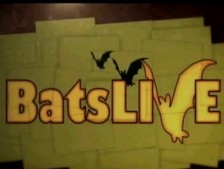BatsLIVE
Bats are vital to healthy ecosystems and human economies worldwide. As primary predators of night-flying insects, bats consume enormous quantities of agricultural pests and reduce the need for chemical pesticides. Yet these wonderfully diverse and beneficial creatures are among the least studied and most misunderstood of animals. Bats are threatened worldwide, and their colonies and habitats are destroyed - both intentionally and inadvertently -- because of myths, misinformation, and lack of scientific knowledge and understanding. Bat populations are declining almost everywhere in North America especially due to the devastating White-nose Syndrome. Losing bats has far-reaching consequences for natural ecosystems and human economies. Knowledge is the key to their conservation and protection.
BatsLIVE: A Distance Learning Adventure is an exciting, free education program for children in the 4 - 8th grades and their educators that brings bat conservation to life in your classroom or community.
Webcasts
Live from Bracken Bat Cave
With millions of Mexican free-tailed bats living in the cave from March through October, Bracken holds one of the largest concentrations of mammals on earth. The emergence of these millions of bats, as they spiral out of the cave at dusk for their nightly insect hunt, is an unforgettable sight. Be sure to check out the spectacular video. Learn about: the Mexican free-tailed bats of Bracken Cave and other bat species, predators that wait for their nightly emergence, threats to bats including White-nose Syndrome, how you can help these beneficial creatures, how bats navigate using echolocation, cave ecology and more.
Bat Basics
Rob Mies with the Organization for Bat Conservation reviews bat biology by showing live bats – including a vampire bat and the impressive Malayan flying fox, which is the largest bat in the world with a wing span of five feet. Bat populations are diminishing and Ann Froschauer, the former National White-Nose Syndrome Communications Leader for the U.S. Fish and Wildlife Service, talks about threats to these diverse and important creatures. Students will also learn about what they can do to help these fascinating mammals.
Webinars
Cave and Karst – The World Beneath our Feet
Cave environments, by their very nature, provide a unique system, which is highly valuable for scientific study and environmental education. Due to the extreme isolation and harsh conditions of the cave environment, caves provide habitat for an array of unusual and rare animal species, including species that are at risk of becoming extinct! Caves are portals to a unique environment and an intriguing web of life - where the forest gives way to the darkness of a cave, scientists have found some of the most remarkable creatures in the world. Within the depths of caves we can also find the remains of ancient life including some of the largest mammals to ever walk the planet such as saber toothed cats, short-faced bears, and giant ground sloths.
Because caves are connected to the surface, we cannot protect them without protecting the lands that contribute water to them. Join us to learn about karst topography and the many special features including springs, sinkholes, underground rivers, and of course, caves that make up this landform. In a karst landscape, water moves very quickly through underground channels with little filtration, making it vulnerable to contamination. Globally, more than one billion people depend on karst terrains for their water supplies.
Bat Education in Your Class and in the Field
This webinar will present activities, resources, and lesson plans to help you teach about bats in your class and in the field. Learn how to put together a bat education trunk, how to take students and adults on a bat walk, how to build and erect a bat house and more.
Bat Basics
Learn about bats, threats to bats, and how to help these beneficial creatures. As primary predators of night-flying insects, bats consume enormous quantities of agricultural pests and reduce the need for chemical pesticides. Yet these wonderfully diverse mammals are among the least studied and most misunderstood of animals. Bats are threatened worldwide, and their colonies and habitats are destroyed because of myths, misinformation, and lack of scientific knowledge and understanding. Bat populations are declining almost everywhere in North America especially due to the devastating White-Nose Syndrome. Losing bats has far-reaching consequences for natural ecosystems and human economies. Knowledge is the key to their conservation and protection. Join us to learn more about these fascinating, secretive mammals!




